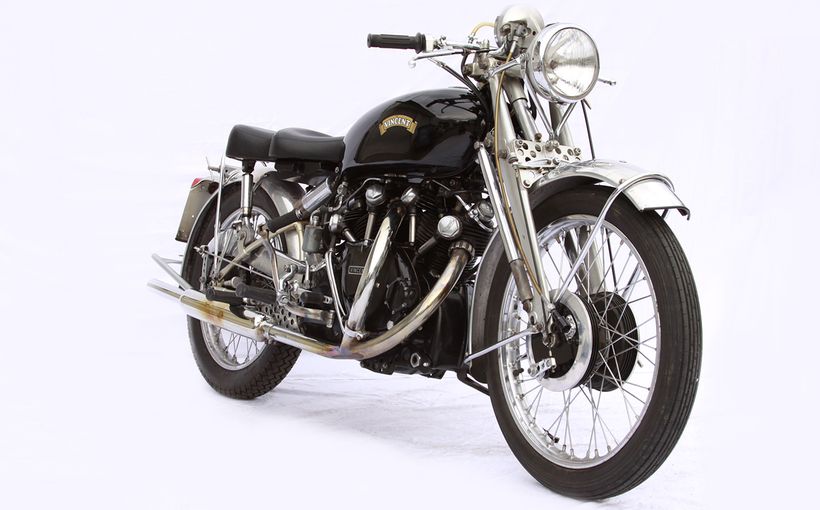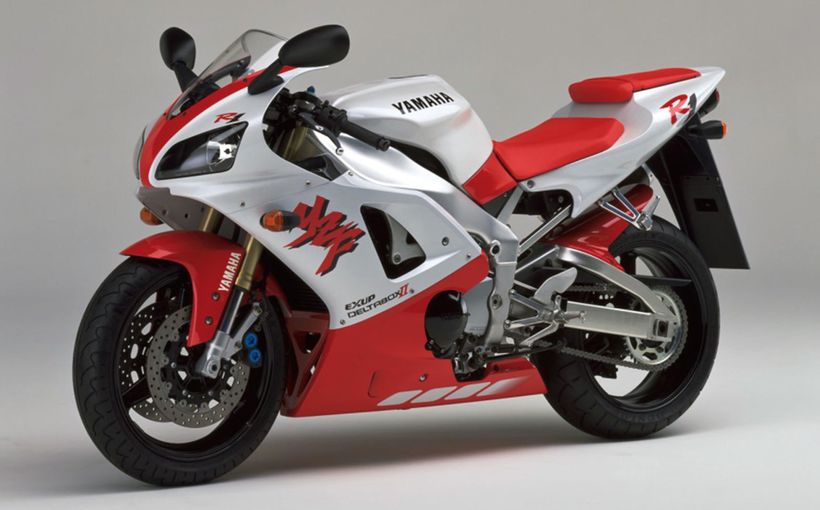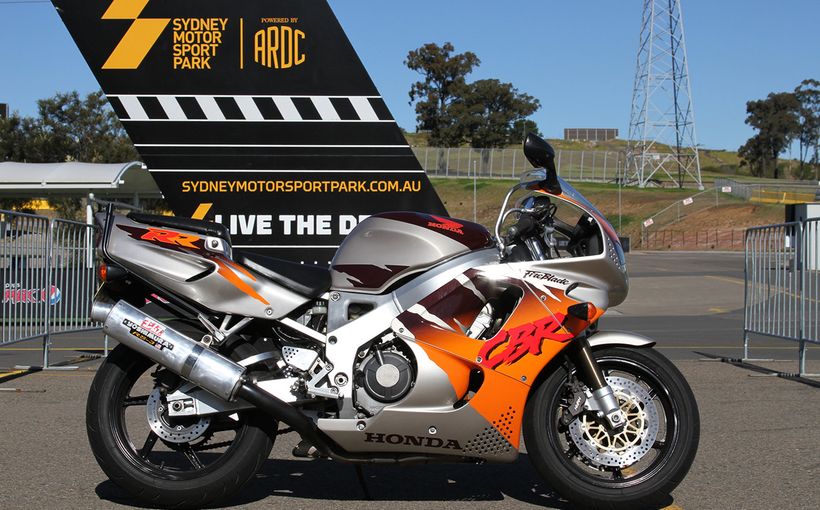Vincent Black Shadow: The Original Superbike, Courtesy of ‘The Two Phils’

From out of the shadow of the valley of death which was World War 2, came the Shadow with a capital letter and whole new meaning – a meaning especially potent in postwar Britain suffering the doldrums of austerity and where (low-octane ‘pool’) petrol was rationed until May 1950, five years after VE Day.
Also, the upper-case V made famous by Prime Minister Winston Churchill in his two-fingered salute, could be said to be the most powerful letter in the British alphabet: V for Victory; V for Vincent.
The Vincent Black Shadow, announced on 24 February 1948, was the fastest production motorcycle in the world. It had a top speed of 128 miles per hour (206km/h). and could accelerate from zero to 90 (145) in less than 15 seconds. It soon acquired such fame that today many enthusiasts believe that the only motorcycle Vincent ever produced was the Black Shadow.
This machine was the original superbike.
We can deduce much of the Black Shadow’s allure from of its most distinctive design detail, a specially created five-inch diameter speedo calibrated to 150 miles per hour. Simply, a standard style three-inch dial would not permit space for the high numbers of which the Black Shadow was capable. In his book, The Vincent Black Shadow, Tim Kingham notes:
The final design was a dial reaching 150 miles per hour with the almost unobtainable goal of all other current motorcycles – the ‘ton’ or 100mph being almost contemptuously reduced to a mere mark without an engraved number.

Imagine: a motorcycle so fast that it demanded a bigger speedometer!
The Black Shadow was essentially a sports version of the Vincent Rapide, mooted in 1945 and in production by September 1946 as the Series B Rapide. The Rapide provided the basis for the Black Shadow and its racing counterpart, the Black Lightning. (There had been a pre-war Vincent Series A with a V-twin of great potential but with no Rapide moniker.)
During the war, PCV lodged some patents and in 1943 The Motorcycle published key ones under the heading ‘A Trend for Thought’, the focus being ‘A 400lb 998cc big twin.
Distinctive elements of the Rapide were the dual seat, ‘Birmabright’ alloy mudguards (as seen on the Land Rover) and Brampton forks as opposed to telescopic, folding footrests and black-painted forks, rear frame and tanks. PCV insisted that the engine be black, achieved by a special process.
The suspension was unique and initiated on the 1928 Vincent-HRD. It used a patented triangulated swing arm at the rear. A stiff sheet-metal spine, doubling as an oil tank, joined the steering head to the Rapide’s cylinder heads. Rear suspension loads were fed into the rear of this box and the engine (as a stressed member) completed the chassis structure. There was no other frame. The rear swing arm pivoted from the back of the engine. Kingham writes: ‘Truly with a Vincent, the frame is taken off the engine, not the engine out of the frame.’

In 1946 just 19 Rapides left the factory, only seven of which remained in the UK due to the government’s Export or Die policy. (The Lagonda Rapide of 1963 would prove to be about equally rare!)
Two men were responsible for engineering the famous V-twin, Philip Conrad Vincent (PCV) himself and the soon-to-be famous Australian, Phil Irving (who even had a ‘v’ in his name!) and would be instrumental in powering Repco-Brabham to Formula One glory. These two, Kingham tells us, were referred to as ‘the two Phils’.

Their engine was an all-alloy 50-degree V-twin with a compression ratio of 6.5:1, about as high as feasible on rationed 65- or 70-octane ‘pool’ fuel. The cylinders were slightly offset to aid the air-cooling. The premium aluminium alloy for the crankcase was sourced from scrapped Rolls-Royce Merlin engines (from the Supermarine Spitfire).
To handle its power, PCV decided to develop his own clutch and (four-speed) gearbox and to enclose them in unit construction with the engine. Especially strong gears were manufactured in EN36 steel. Tall gearing gave 100mph (161km/h) at just 4600rpm.
Kingham refers to an 11 August 1949 road test by The Motorcycle:
The recorded speed was 110mph in third and with a flair for showmanship that even eclipses PCV’s efforts in that regard, instead of quoting a maximum speed in top gear, they repeated that immortal phrase ‘maximum speed not obtained’. In actual fact, they had uttered the same phrase two years before, when they tested the Series B Rapide. However, on this latest occasion the time for the quarter mile was a second quicker and the terminal speed at 96mph was 10mph faster.
According to the tester: ‘It is a connoisseur’s machine…one of the outstanding designs of all time…the mighty Black Shadow must be awarded 99 out of 100 marks: 99 because nothing, it is said, is perfect.’

To grasp the almost fabulous nature of the Black Shadow’s performance, we need to understand the British context of dire austerity (and the dramatic contrast with the prosperous United States of America where new-gen chrome-bedecked, super-sized cars powered by high-compression V8 engines stalked the streets). Many automotive manufacturers made do with reheated pre-war models.
The first company to preview genuinely new models was upmarket Armstrong Siddeley. But these 2.0-litre machines struggled to reach 75 miles per hour and took half a minute to achieve their cruising speed of 60. (The first motorway would not be opened until 1959 and 45-50 between villages was deemed satisfactory.)
Nineteen forty-eight was also the year of Alec Issigonis’s Morris Minor. Issigonis had wanted to develop an advanced new engine but got stuck with an anaemic pre-war side-valve unit. Under favourable conditions this Minor might just achieve 60 miles per hour (after perhaps a full minute’s straining aspiration!) Cruising speed was 45. As Kingham notes, you could be stuck behind slow traffic seemingly interminably: ownership of a Black Shadow was your ticket to ride!

At the dizzy limits of performance was Jaguar’s new XK120 (XK the engine designation, 120 the maximum speed).
Australia’s Own Holden appeared in late 1948, the world’s only sedan to boast this trifecta – a kerb weight of just one old-fashioned ton (1010kg), top speed of 80mph and the possibility of 30mpg.
So, by any standards of performance, in its day the Black Shadow was astonishing and it would essentially take two decades for motorcycles such as the Suzuki 500 and Triumph Trident to surpass its figures.
Many ‘Black Shadows’ are Rapides, so it is critical to understand Vincent’s engine and chassis numbering system. There should be a 1B on the engine and a B suffix on the frame. But prospective buyers should consult the Vincent Owners Club Registrar for authentification.
Wikipedia notes:
In 2007 the Vincent H·R·D Owners Club commissioned the VOC Spares Company Limited to build a replica Black Shadow from new parts. The goal of the project was to prove that all parts were in stock and available from the VOC Spares Company Limited. Having received glowing reviews from the motorcycle press in the UK, the machine was auctioned by Bonhams and eventually went on display at a museum in New Zealand.
The Black Shadow received minor modifications during its six-year life, some of which arguably devalued the machine, particularly the loss of the five-inch speedo and the decision to cease painting the engine black.

A total of 1774 Black Shadows and 15 White Shadows (identical other than having the engine polished rather than painted) were made. There can be no more telling example of the glory days of the big-bore motorcycle.
The final example was built in December 1954 and sold in March 1955. The Vincent company shut its doors, but has been revered ever since.









